Gazing up at the star-studded night sky, it’s easy to wonder if we’re truly alone in the vast universe. For centuries, humanity has dreamt of other worlds. Modern astronomy is now turning those dreams into reality. Since 1992, astronomers have discovered over 5,000 exoplanets, each with a unique story to tell.
In this article, we explore the top 10 most fascinating exoplanets discovered so far, from the iron-raining WASP-76b to the potential life-harboring Kepler-186f. These celestial bodies are not just dots of light in the sky, they are dynamic worlds with extraordinary characteristics that challenge our understanding of the universe and ignite our imagination.
Top 10 Most Fascinating Exoplanets Discovered
Our Milky Way galaxy is home to billions of stars, each with its own celestial entourage of planets. Some of these planets are so strange and alluring that they defy expectations, rewrite textbooks, and capture our attention. Here, we look at 10 of the most fascinating exoplanets discovered. Exploring their unique properties and the potential they hold for understanding the universe and the possibility of life beyond Earth.
ALSO READ: Voyager 1 Glitch Challenges Decades-Old Spacecraft, But Engineers Unravel the Mystery
WASP-76b: Raining Iron, Anyone?
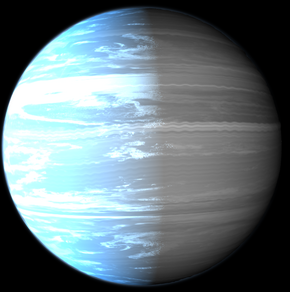
Discovery and Characteristics
Discovered on October 21, 2013, by R.G. West et al., WASP-76b is a gas giant exoplanet that resides approximately 640 light-years away from Earth. This distant world orbits its parent star so closely that it completes a full orbit in just 1.8 Earth days. Due to this proximity, WASP-76b remains tidally locked, with one side perpetually facing the star and the other in eternal darkness. This constant exposure to intense stellar radiation creates extreme temperature variations between the two hemispheres.
Unique Weather Patterns
WASP-76b is famous for its bizarre and extreme weather patterns.The dayside of the planet reaches up to 4,532°F (2,500°C), hot enough to vaporize iron. Strong winds carry the vaporized iron to the cooler nightside, where temperatures drop to around 1,832°F (1,000°C). Here, the iron condenses and falls as molten iron rain. This dramatic weather phenomenon is one of the most extraordinary examples of the diverse and extreme conditions that can exist on exoplanets.
Scientific Significance
The discovery of WASP-76b and its unusual weather patterns has significant implications for our understanding of exoplanetary atmospheres and weather systems. The detection of iron rain was made possible using the ESPRESSO instrument on the Very Large Telescope in Chile, showcasing the advanced technology and methods astronomers use to study distant worlds. This discovery highlights the diversity of exoplanetary environments and challenges our understanding of atmospheric dynamics.
HD 189733b: Where Glass is Always Falling
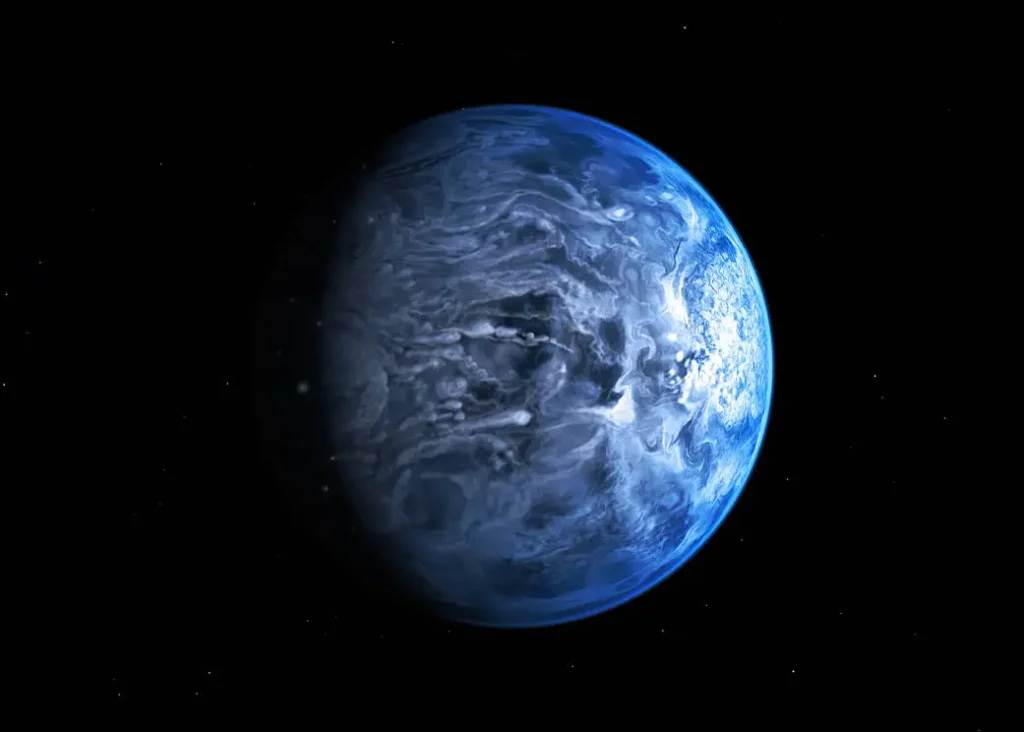
Discovery and Characteristics
Bouchy et al. discovered HD 189733b, a gas giant exoplanet, on October 5, 2005. This exoplanet orbits a star located 64.5 light-years from Earth in the constellation Vulpecula. HD 189733b is notable for its deep blue color, reminiscent of Earth’s oceans. However, this appearance is deceptive, as the planet’s conditions are anything but Earth-like. The planet completes an orbit around its star in just 2.2 Earth days, indicating a very close and scorching orbit.
Unique Weather Patterns
HD 189733b experiences some of the most extreme weather patterns known. The planet endures temperatures reaching up to 3,632 degrees Fahrenheit (2,000 degrees Celsius) on its dayside. These extreme temperatures cause silicate particles in the atmosphere to condense into tiny glass droplets. Supersonic winds exceeding 5,400 miles per hour whip these glass particles around the planet, creating a deadly environment of high-speed glass rain.
Scientific Significance
The unique weather phenomena on HD 189733b provide crucial insights into atmospheric dynamics on exoplanets. Scientists made the discovery of glass rain through spectral analysis, demonstrating the power of advanced observational techniques. This information helps scientists understand the composition and behavior of exoplanetary atmospheres under extreme conditions.
Gliese 1132b: The Phoenix Planet
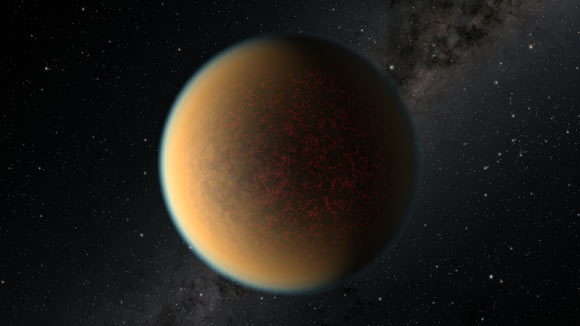
Discovery and Characteristics
The MEarth-South array team discovered Gliese 1132b on May 10, 2015.This exoplanet orbits a red dwarf star located approximately 39 light-years away in the constellation Vela. Gliese 1132b is an Earth-sized planet with a radius about 1.16 times that of Earth. Its host star tidally locks Gliese 1132b, meaning one side constantly faces the star while the other remains in darkness. The proximity to its star results in extreme surface temperatures, with the dayside reaching around 800 degrees Fahrenheit (427 degrees Celsius).
Volcanic Renaissance
Gliese 1132b experienced a dramatic event that stripped it of its original atmosphere due to intense stellar radiation from its red dwarf star. However, the story does not end there. The immense tidal forces exerted by the star have triggered intense volcanic activity on the planet. This volcanic renaissance is causing the planet to emit gases such as hydrogen, methane, and hydrogen cyanide, which are slowly forming a new atmosphere. This regeneration of the atmosphere showcases the planet’s resilience and its ability to sustain geological activity despite harsh conditions.
Scientific Significance
The unique situation of Gliese 1132b provides a valuable case study for understanding planetary evolution and atmospheric dynamics. The loss and subsequent regeneration of the atmosphere offer insights into the resilience of planetary systems in extreme environments. Studying this volcanic activity can help scientists understand the geological processes that can sustain or regenerate atmospheres on other planets.
ALSOE READ: Earth’s Magnetic Field – Everything You Need To Know
Kepler-10b: Mustafar in Real Life?
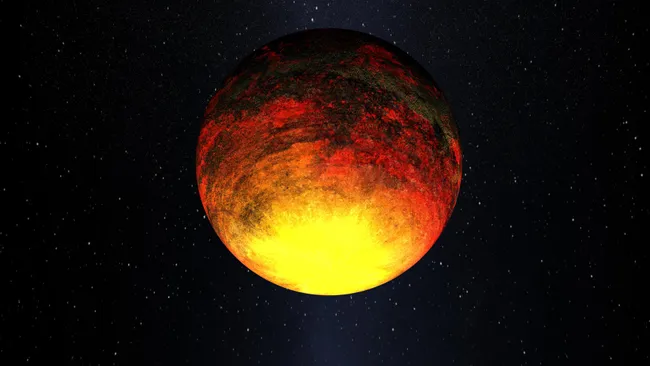
Discovery and Characteristics
Kepler-10b was discovered by NASA’s Kepler mission and announced in January 2011. It is located about 560 light-years away in the constellation Draco. Kepler-10b is notable for being one of the first confirmed rocky exoplanets. With a radius of approximately 1.4 times that of Earth and a mass about 4.6 times greater, it has a high density, indicative of a rocky composition similar to Earth’s. The planet orbits very close to its host star, completing an orbit in just 0.84 days (20 hours).
Fiery Conditions
Kepler-10b is a scorched world, with surface temperatures reaching around 2,500 degrees Celsius (4,532 degrees Fahrenheit) on the dayside due to its close proximity to its star. This extreme heat is sufficient to melt and vaporize rock. The intense radiation from the star means that any atmosphere the planet might have had would have long since evaporated, leaving a barren, rocky surface. The planet’s high density suggests it has a large iron core, contributing to its classification as a “super-Earth.”
Scientific Significance
The discovery of Kepler-10b marked a significant milestone in the search for exoplanets, particularly rocky ones similar to Earth. It provided one of the first opportunities to study a rocky exoplanet outside our solar system, offering valuable data on the composition and characteristics of such planets.
Kepler-10b’s extreme conditions also offer insights into planetary formation and evolution. Studying its molten surface and the processes occurring there helps scientists understand the behavior of rocky planets in high-radiation environments. This knowledge is crucial for modeling the conditions of other rocky exoplanets, particularly those that might be in the habitable zones of their stars but experience intense stellar radiation.
Upsilon Andromedae b: A Tale of Two Temperatures
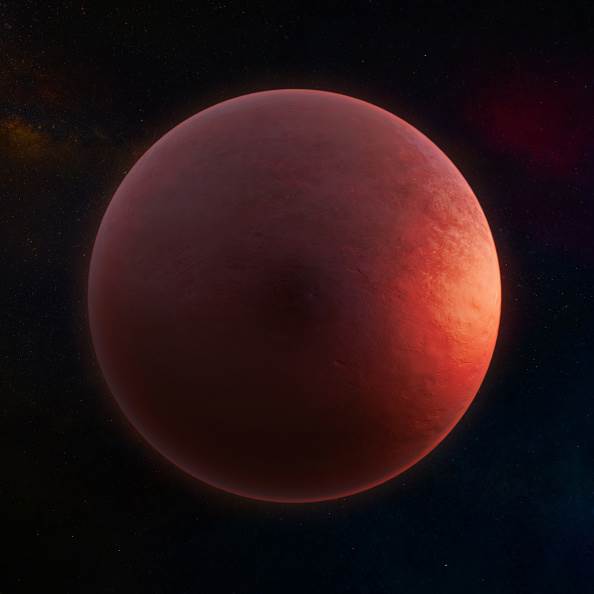
Imagine a planet with a dayside hot enough to melt metal and a nightside frozen solid. Welcome to Upsilon Andromedae b! This extreme world experiences drastic temperature swings due to its tidal locking and the unique position of a hot spot on its host star. It’s a world of fire and ice, showcasing the diverse and often unpredictable nature of exoplanetary systems.
Discovery and Characteristics
Upsilon Andromedae b, often abbreviated as Upsilon And b, was discovered in 1996 orbiting the star Upsilon Andromedae in the constellation Andromeda. This exoplanet is part of a multi-planet system, with at least three other known planets orbiting the same star. Upsilon Andromedae b is classified as a gas giant, similar in size to Jupiter but with significantly more mass. It orbits very close to its parent star, completing an orbit in just 4.6 Earth days.
Extreme Temperature Differences
One of the most striking features of Upsilon Andromedae b is the stark contrast in temperature between its day and night sides. Like many exoplanets in close orbits around their stars, Upsilon Andromedae b is tidally locked, meaning one side always faces the star while the other remains in perpetual darkness. This results in extreme temperature differentials.
The dayside of Upsilon Andromedae b experiences scorching temperatures, reaching up to 2,400 degrees Celsius (4,352 degrees Fahrenheit) or higher due to its proximity to the star. In contrast, the nightside of the planet is much cooler, with temperatures dropping to around -210 degrees Celsius (-346 degrees Fahrenheit) or even lower. This drastic variation creates a stark divide between a blistering hot dayside and a frigid nightside.
Scientific Significance
Upsilon Andromedae b provides a unique opportunity to study the atmospheric dynamics and heat distribution on a tidally locked exoplanet. The extreme temperature differences between its day and night sides offer valuable insights into the circulation patterns and energy transport mechanisms within its atmosphere.
Studying Upsilon Andromedae b’s atmosphere can help scientists better understand the behavior of exoplanetary atmospheres under extreme conditions. Observations of temperature variations and atmospheric composition can provide clues about the planet’s climate, weather patterns, and potential habitability factors.
HR 5183b: The Whiplash Planet

Buckle up for this one! HR 5183b, a gas giant three times the mass of Jupiter, takes eccentricity to a whole new level. This planet’s orbit differs from most, tracing a wildly elliptical path around its star. It ventures closer than Jupiter, then swings out to the system’s fringes. It’s a reminder that even in the seemingly predictable realm of planetary orbits, surprises await.
Discovery and Characteristics
HR 5183b is an exoplanet discovered orbiting the star HR 5183, located approximately 103 light-years away in the constellation Virgo. The planet was detected using radial velocity measurements. This tracks the subtle wobbles induced in a star’s motion by the gravitational pull of an orbiting planet. HR 5183b is classified as a gas giant, with a mass approximately three times that of Jupiter. It orbits its host star in an eccentric orbit, meaning its path around the star is highly elongated rather than circular.
Eccentric Orbit
What sets HR 5183b apart is its highly eccentric orbit, which distinguishes it from most other exoplanets discovered to date. HR 5183b’s orbit is markedly different from the nearly circular orbits of most planets. It follows a significantly elongated path, venturing closer to its star at periastron than Jupiter does to the Sun. At apastron, it swings out to a much greater distance than Jupiter’s average distance from the Sun.
Scientific Significance
The eccentric orbit of HR 5183b presents a puzzle for astronomers and planetary scientists. Extreme orbits like HR 5183b’s are relatively rare among known exoplanets. The mechanisms behind their formation and stabilization remain incompletely understood. One possible explanation for HR 5183b’s eccentricity is gravitational interactions with other bodies in its planetary system.
Studying HR 5183b and its orbit offers valuable insights into planetary system dynamics. Observing planets like HR 5183b refines models of planetary formation and evolution, shedding light on planetary system architecture.
OGLE-2016-BLG-1928: The Lone Wolf Exoplanet
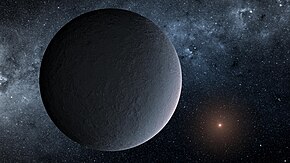
Forget hitching a ride on a star – OGLE-2016-BLG-1928 is a cosmic nomad, a rogue exoplanet untethered to any star system. This Earth-sized world wanders the Milky Way alone, a testament to the dynamic and sometimes chaotic nature of planetary formation. It raises intriguing questions about the number of these loner planets out there and the possibility of life finding a way even in interstellar isolation.
Discovery and Characteristics
OGLE-2016-BLG-1928 is an intriguing exoplanet discovered through gravitational microlensing. A phenomenon where the gravitational field of a foreground object, such as a star, magnifies and distorts the light from a background object, such as a more distant star. This effect can also magnify the light from a planet orbiting the foreground star, allowing astronomers to detect it indirectly.
This exoplanet is unique because it does not orbit a star. Instead, it travels through space without being gravitationally bound to any stellar system. Its discovery challenges traditional notions of planetary formation and highlights the existence of “rogue” or “orphan” planets in the galaxy.
Rogue Planet Nature
Rogue planets like OGLE-2016-BLG-1928 form similarly to other planets, from material collapsing within a protoplanetary disk. However, they either fail to become gravitationally bound to a star or are ejected from their parent system due to gravitational interactions.
Untethered to any star, rogue planets roam space alone. Detecting them via traditional methods like transit or radial velocity measurements is challenging. Instead, their presence is inferred through gravitational microlensing events, where their gravitational influence distorts the light of background stars.
Scientific Significance
The discovery of OGLE-2016-BLG-1928 and other rogue planets has significant implications for our understanding of planetary formation and the prevalence of such objects in the galaxy. These planets represent a population that was previously difficult to detect and study, leading to uncertainties in estimates of the total number of planets in the Milky Way.
Studying rogue planets like OGLE-2016-BLG-1928 provides insights into the processes of planet formation and evolution outside of the traditional star-bound paradigm. By understanding the prevalence and properties of rogue planets, astronomers can refine models of planetary formation and migration, shedding light on the diversity of planetary systems in the universe.
The TOI-178 System: Harmony and Chaos Collide
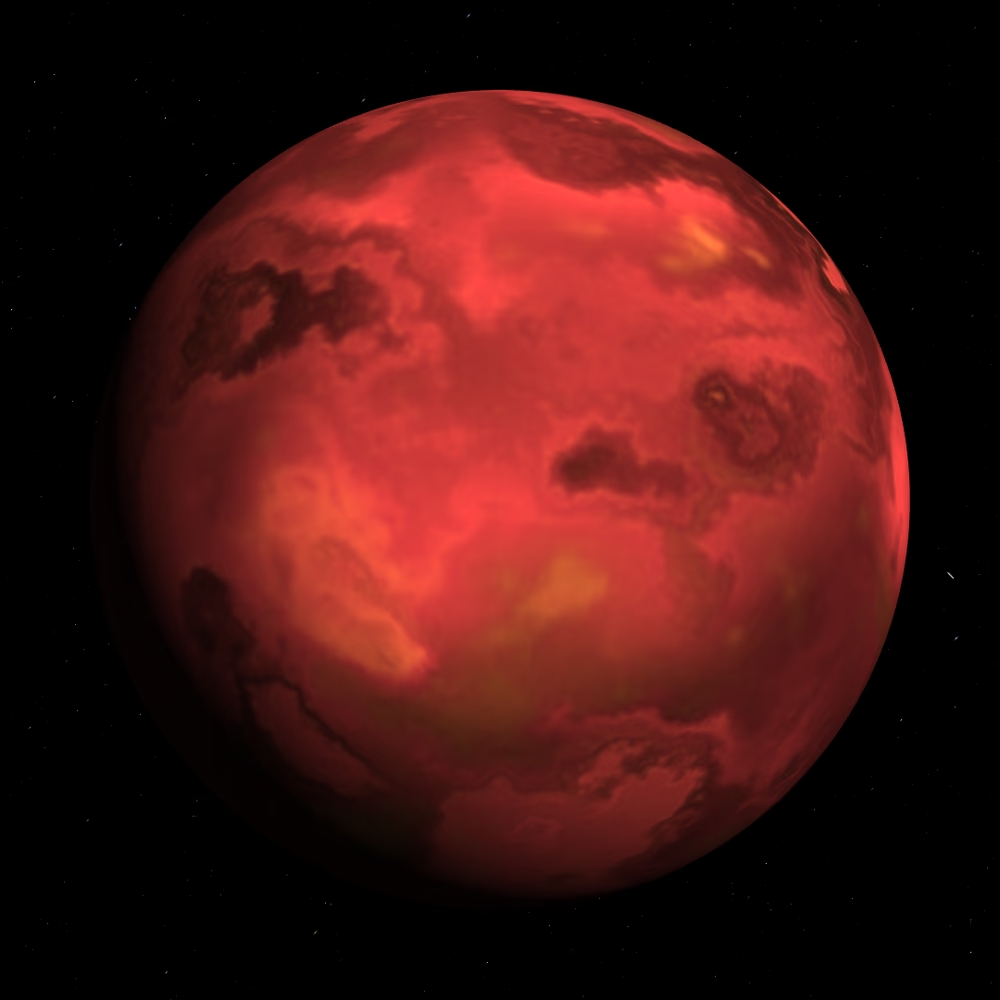
This system boasts five planets locked in a mesmerizing orbital dance, completing their revolutions in precise ratios. It’s a testament to the delicate balance that can govern planetary systems. But don’t get too comfortable – the planets themselves are a motley crew, ranging from dense Earth-like worlds to puffy giants, highlighting the diversity that can exist even within a single system.
Discovery and Characteristics
The TOI-178 system, located approximately 205 light-years away from Earth, is home to a fascinating array of exoplanets that defy conventional expectations. Discovered through observations from the Transiting Exoplanet Survey Satellite (TESS), this system has drawn significant attention due to the unique orbital dynamics exhibited by its planetary inhabitants.
Orbital Resonance
One of the most remarkable features of the TOI-178 system is the phenomenon known as orbital resonance, where the planets’ orbital periods form simple integer ratios with one another. In other words, the planets’ positions align in specific configurations as they orbit their host star, creating a mesmerizing celestial dance of gravity and motion.
The precise ratios of these resonances contribute to the system’s apparent harmony, with the planets periodically lining up in configurations that repeat over time. This resonance can create stable orbital configurations that endure for millions or even billions of years, despite the gravitational interactions between the planets.
Scientific Significance
The TOI-178 system offers a unique laboratory for studying the interplay between order and chaos in planetary systems. While the resonant orbits suggest a sense of harmony, the diversity of the planets themselves hints at underlying complexity and variability.
By studying the TOI-178 system’s orbital dynamics and planetary compositions, astronomers can gain insights into the mechanisms that drive planetary formation and evolution. The presence of resonant orbits challenges existing models of planetary migration and stability, prompting researchers to refine their understanding of these processes.
55 Cancri e: A Diamond in the Rough
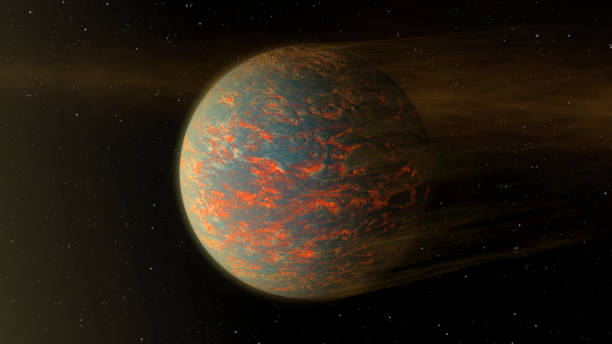
Discovery and Characteristics
Imagine a planet where diamonds rain not from the sky, but from the scorching depths of its fiery interior. This isn’t some fantastical story, it’s the intriguing possibility surrounding 55 Cancri e, a “diamond planet”. 55 Cancri e is an exoplanet located in the system of the star 55 Cancri, approximately 41 light-years away from Earth in the constellation of Cancer. Discovered in 2004, this exoplanet has garnered significant attention due to its unique characteristics and potential composition.
The planet orbits its host star very closely, completing one orbit in just 18 hours, making it one of the shortest orbital periods known for an exoplanet. It is classified as a “super-Earth” due to its size, being roughly twice the diameter of Earth and about eight times its mass.
Potential Diamond Composition
One of the most intriguing aspects of 55 Cancri e is its composition, which has led to its nickname as the “diamond planet.” While not confirmed, astronomers have theorized that the intense heat and pressure on the surface of 55 Cancri e could cause carbon atoms to crystallize into diamond structures.
The planet’s proximity to its host star results in surface temperatures that exceed 2,000 degrees Celsius, hot enough to vaporize rock and metal. The extreme conditions present on 55 Cancri e make it a prime candidate for unique forms of mineral formation, potentially including diamond.
Scientific Significance
The possibility of 55 Cancri e being composed partially or entirely of diamond has significant implications for our understanding of planetary formation and evolution. If confirmed, it would represent the first known case of a planet with a substantial diamond content.
Studying the composition and properties of 55 Cancri e can provide valuable insights into the processes of planetary formation in extreme environments. Understanding how planets like 55 Cancri e form and evolve can shed light on the diversity of planetary compositions and the conditions necessary for the emergence of materials.
Kepler-186f: The First Earth-Sized Goldilocks Planet
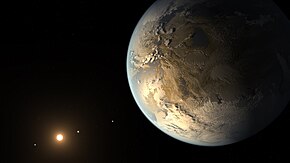
Discovery and Characteristics
Kepler-186f holds a significant place in the annals of exoplanetary discoveries as it marks the first confirmed Earth-sized exoplanet found within the habitable zone of its host star. Discovered by NASA’s Kepler space telescope in 2014, Kepler-186f orbits a red dwarf star known as Kepler-186 approximately 500 light-years away in the constellation Cygnus.
This exoplanet has a radius only slightly larger than Earth’s, making it the closest approximation to our home planet found outside the solar system. Its location within the habitable zone, also known as the “Goldilocks zone,” positions Kepler-186f at a distance from its host star where temperatures could allow for the existence of liquid water on its surface, a key ingredient for life as we know it.
Habitable Zone Significance
The habitable zone around a star is defined as the range of distances at which a planet could maintain surface temperatures suitable for liquid water to exist. For Kepler-186f, being located within this zone means that it receives just the right amount of stellar radiation to potentially support liquid water on its surface, making it a prime candidate in the search for extraterrestrial life.
The significance of Kepler-186f’s position within the habitable zone lies in its potential to harbor conditions conducive to life. While the presence of liquid water does not guarantee the existence of life, it is considered a crucial factor in the search for habitable environments beyond Earth.
Scientific Significance
Kepler-186f represents a milestone in our quest to understand the prevalence and diversity of potentially habitable worlds beyond our solar system. Its discovery has broadened our perspective on where and how Earth-like planets might exist in the galaxy, highlighting the possibility of finding other habitable worlds orbiting stars different from our own.
Studying Kepler-186f and similar exoplanets provides valuable insights into the conditions necessary for the emergence and sustainability of life elsewhere in the universe. By characterizing the properties of these planets and their host stars, astronomers can refine models of planetary formation and evolution, as well as assess the likelihood of finding life beyond Earth.
Conclusion
Summary of Key Points
Throughout this exploration, we have delved into the remarkable diversity and unique characteristics of various exoplanets:
- WASP-76b is known for its extreme weather, where iron vaporizes on the day side and condenses into iron rain on the night side.
- HD 189733b features high-speed winds carrying silicate particles, resulting in glass rain that reflects blue light.
- Gliese 1132b has experienced a volcanic renaissance, with signs of resurfacing after losing its original atmosphere.
- Kepler-10b resembles the fictional Mustafar with its incredibly high surface temperatures and volcanic activity.
- Upsilon Andromedae b showcases extreme temperature variations between its day and night sides due to its tidally locked orbit.
- HR 5183b displays a highly eccentric orbit, illustrating the dynamic and sometimes chaotic nature of planetary systems.
- OGLE-2016-BLG-1928 is a rogue planet, highlighting the existence of planets not bound to any star.
- The TOI-178 system exhibits an intricate orbital resonance among its planets, creating a unique combination of harmony and chaos.
- 55 Cancri e may have a surface rich in carbon, potentially in the form of diamonds, hinting at fascinating planetary compositions.
- Kepler-186f is the first Earth-sized planet found in the habitable zone of its star, offering a tantalizing possibility for life.
Future of Exoplanet Research
The future of exoplanet research is bright and full of potential. Technological advances, such as the James Webb Space Telescope (JWST) and the upcoming European Space Agency’s PLATO mission, will allow scientists to study exoplanets with unprecedented detail. These missions aim to analyze the atmospheres, climates, and potential signs of life in distant worlds. Ground-based telescopes with adaptive optics and next-generation instruments will complement space-based observations, providing a comprehensive view of exoplanetary systems.
These are just a handful of the fascinating exoplanets astronomers have discovered so far. Each one reveals a unique piece of the puzzle, helping us understand the formation and diversity of planetary systems and the potential for life elsewhere in the universe. As our telescopes become more powerful and our techniques more sophisticated, we can expect to find even more strange and wonderful worlds out there, pushing the boundaries of our knowledge and igniting our collective sense of wonder. Let me know the planets that fascinates you most in the comment section below!!!
